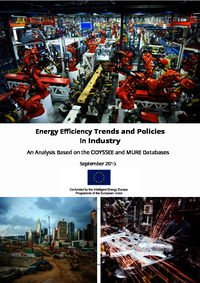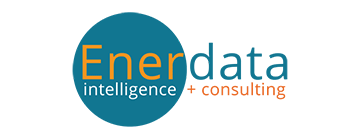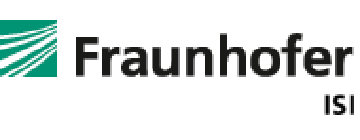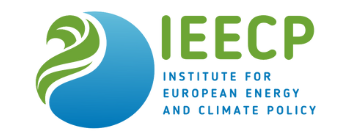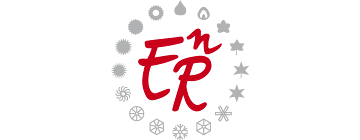Summary
This report proposes an evaluation of energy efficiency progress achieved in industry since 2000 at EU level. The analysis includes both a review of energy efficiency trends and of the policy instruments currently implemented to improve energy efficiency. The analysis is based on the information containing in the ODYSSEE and MURE databases.
With the Energy Efficiency Directive from 2012 (2012/27/EU) the Member States are obliged to meet their national energy efficiency target set in Article 3 EED and the 1.5% energy saving target from Article 7 of the EED. The EED also includes specific regulations for this sector, especially Article 8 on energy audits. The achievement of the new 2030 target for energy efficiency, which prescribes a reduction of primary energy consumption by 27% compared to a reference development, will also need contributions from all end-use sectors.
Key Messages – Energy Efficiency Trends and Policies in Industry
Trends
- Industrial energy consumption has remained roughly stable at EU level between 2000 and 2007 and has decreased rapidly since then with a contraction twice faster than the industrial activity.
- As a result, industrial consumption was in 2013 17% below its 2000 level at EU level and only represented 25 % of the energy used by final consumers, compared to 29% in 2000.
- Between 2000 and 2007, the stability of consumption was the result of the balance between the increase in industrial activity and energy savings.
- Since 2007, more than half of the reduction in consumption was linked to the decrease in industrial activity and only one fourth to energy savings.
- Energy savings were 2.5 times lower since 2007 than over 2000-2007,as there has been a much slower energy efficiency progress since the recession (0.9%/year since 2007 compared to 1.9%/year before), because of a slower progress in most branches and even no more improvement for some others (e.g. steel, cement, machinery). On average, energy efficiency has improved by 1.4%/year in the EU since 2000.
- This slower progress in energy efficiency is due to the recession, as the consumption did not follow the reduction of activity, because, on the one hand the large equipment did not operate at full capacity and were thus less efficient, and, on the other hand, part of the consumption is not linked to the level of production.
- The market share of electricity, biomass and heat in industry has progressed significantly (+4 points for electricity since 2000; +3 points each for biomass and heat).
- Chemical industry is the main energy consuming branch with 19% of total industrial consumption in 2013, followed by steel with 18%; while the share of chemicals is progressing (+1.5 points at EU level since 2000), the share of steel is declining (- 2 points).
- Since 2007 the energy consumption has decreased in all industrial branches: steel and non-metallic minerals experienced the strongest reduction with consumption 25% lower in 2013 than in 2000.
Policies and Measures
- Financial measures are the by far dominating measure type in industry in almost all EU Member States. Around half of the policies addressing energy efficiency in industry can be attributed to this type. However, the new “Successful Policies” facility in MURE shows that in many countries the remaining part of the the policies in place includes a broad mix of other types (incl. new market-based instruments).
- The financial crisis since mid 2008 did not considerably change the dominance of financial measures. They are still dominating the policy mix and became even more important since 2013. Only in some countries which were hardest hit by the crisis (esp. Ireland, Portugal, Italy, Spain and Greece), no or only very few new financial measures have been implemented after 2008.
- The Energy Efficiency Directive (2012/27/EU) also triggered new energy efficiency policies in the Member States. With regard to industry, these are especially measures introduced under Article 7 (energy efficiency obligations and/or alternative measures), mandatory audits (Article 8) and new certification/qualification schemes. NEEAP measures, i.e. measures reported in the NEEAP 1 and/or NEEAP 2 and/or NEEAP 3, constitute about 50% of the total measures in the industrial sector in MURE.
- There is no clear correlation between the impact level of the measures and the measure types. Both high-impact and low-impact measures are of various types. Only informative measures usually have a relative low impact and are mainly seen as accompanying measures in a policy mix.
- Energy audits and energy management can be seen as important instruments to recognise and observe existing economic energy efficiciency potentials by systematic procedures to gain knowledge and developing a strategy to achieve energy efficiency targets. Insofar they play a crucial role in a policy mix for the industrial sector. One central element to wider spread this kind of instruments in Europe is the implementation of Article 8 of the EED, which is, however, delayed in several Member States. To the date of June 2015, some Member States did not even deliver a national response to Article 8 to the European Commission.
- While several energy efficiency measures are already in place for small and medium enterprises (SMEs), more tailored programmes are needed to address their special needs. The MURE database shows several best practice examples from countries where SMEs already are an important target group for energy efficiency policies.
- A suitable policy mix addressing energy efficiency in industry should both break down the most important barriers which hinder the uptaking of energy efficiency measures in companies (as e.g. information and knowledge deficits, several uncertainties, low priority fore energy efficiency investment or high transaction costs), and make use of the driving forces which facilitate the implementation of energy efficiency efficiency measures (as e.g. positive image of energy efficiency, motivated employees). A suitable policy package for industry should therefore comprise regulatory as well as the other incentivising instruments (“stick and carrot”), where the regulatory instruments define the technological baseline. The other instruments may then either encourage the investor to undertake measures complying with this baseline or they may set incentives to even exceed the standards significantly and make use of more advanced technologies.
- If this kind of policy package is designed for industry, a specific energy use in industry will usually be targeted by several policy measures. In that case, measure interactions can occur, i.e. measures in the package may reinforce each other but they could also counteract against each other. These measure interactions have to be taken into account in order to assess the impact of the policy actions on the EU (or national) energy efficiency targets in a realistic manner. The new MURE “Policy interaction” facility provides a flexible tool to catch these impacts in a user-friendly way.
Archives
Energy Efficiency Policies in Industry in the EU: September 2012
